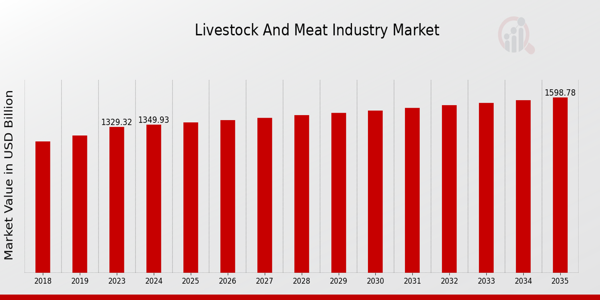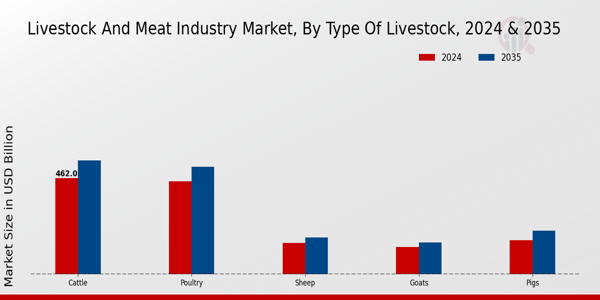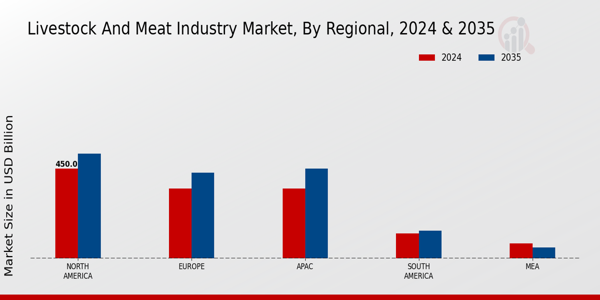Global Livestock and Meat Market Overview
Livestock and Meat Market Size was estimated at 1,329.32 (USD Billion) in 2023. The Livestock and Meat Industry is expected to grow from 1,349.93 (USD Billion) in 2024 to 1,600.0 (USD Billion) by 2035. The Livestock and Meat Market CAGR (growth rate) is expected to be around 1.55% during the forecast period (2025 - 2035).

Key Livestock and Meat Market Trends Highlighted
A number of significant factors are influencing the livestock and meat market, including shifting consumer tastes, technology breakthroughs, and sustainability issues. The increasing need for diets high in protein as more people worldwide place a higher priority on eating meat for nourishment is a major market driver.
Furthermore, a greater range of beef products are becoming more accessible in emerging nations as disposable incomes rise. Consumer choices are also being influenced by health concern, which has increased interest in sustainable and organic beef products.
The importance of food safety and traceability in the supply chain is growing, which is driving producers to implement improved procedures and technological advancements.
There are chances to focus on alternative proteins and develop new product lines. Growing consumer interest in lab-grown and plant-based meats presents an opportunity for businesses to expand their product lines and win over dietary restrictions and health-conscious customers.
Further, expanding into emerging markets can help to tap into new consumer bases that are beginning to demand higher-quality meat products. The integration of advanced technologies in livestock management, such as automation and data analytics, presents further potential for efficiency improvements and cost reductions.
Recent trends show an emphasis on ethical sourcing and environmental sustainability, as consumers are increasingly concerned with the impact of meat production on the planet.
Innovations in packaging and preservation methods are also gaining traction, aimed at reducing food waste and improving shelf life. Vertical integration in the supply chain is becoming common, allowing companies to manage quality more effectively from farm to fork.
Overall, adaptability and responsiveness to evolving consumer demands will be crucial for players in the Livestock and Meat Market.
Livestock and Meat Market Drivers
Increasing Population and Urbanization
The rapid growth of the population and the trend toward urbanization are significant drivers of the Livestock and Meat Market.
As more people move into urban areas, there is an increasing demand for accessible and convenient food sources, particularly protein-rich foods such as meat. Urban consumers tend to prefer a varied diet that often includes a significant portion of meat products, leading to higher consumption rates.
Furthermore, as populations grow, the pressure on food production systems intensifies. This demand steers innovation in livestock and meat production, pushing industries to adopt more efficient practices. The shift in dietary preferences, especially in developing nations and emerging economies, elevates the demand for livestock products, consequently driving market growth. This surge in consumption is not merely a reflection of numbers; it encompasses a shift in lifestyle choices as well.
An urbanizing population is often more receptive to modern practices associated with livestock and meat industries, which further enhances the overall market landscape. Moreover, increasing income levels in many parts of the world are enabling consumers to allocate more of their budgets to protein-rich foods, which directly impacts the growth trajectory of the Livestock and Meat Market.
As people tend to have busier lifestyles, there is also a growing preference for ready-to-eat meat products, which has expanded the market opportunities in both prepared foods and online food delivery services.
Consequently, all these factors combined underscore the essential role of demographic shifts in driving the Livestock and Meat Market.
Technological Advancements in Livestock Farming
The evolution of technology has been a crucial catalyst for growth within the Livestock and Meat Market. Innovations such as precision farming, genetic improvements, and automation are reshaping how livestock is raised and managed.
This technological progress enhances productivity and efficiency, reducing the costs associated with meat production while improving the quality of the meat itself. Innovations in feed efficiency technology and health management practices contribute to better livestock health, thereby increasing overall meat supply.
Furthermore, advancements in food safety technologies help mitigate the risks of contamination, ensuring a safer product for consumers. As producers adopt these strategies, the overall efficiency of meat production escalates, consequently supporting the burgeoning demand for beef, pork, and poultry.
Shifts in Consumer Preferences toward Protein Sources
Changes in consumer preferences, with a notable inclination toward protein-rich diets, are significantly shaping the Livestock and Meat Market.
In recent years, a surge of interest in high-protein diets, driven by health trends and fitness, has propelled meat consumption to new heights. Consumers are increasingly seeking gourmet products, organic options, and specialty meat sources, leading to broader product diversification in the market.
This shift is not only a response to dietary needs but also reflects an evolving culinary landscape where meat plays a central role. Additionally, the rise of flexitarian and high-protein diets is influencing purchasing decisions, bolstering demand for various meat products while encouraging sustainable practices within the livestock sector.
Livestock and Meat Market Segment Insights
Livestock and Meat Market Type of Livestock Insights
The Livestock and Meat Market showcased a diversified structure, with Type of Livestock playing a pivotal role in defining market dynamics.
In 2024, the valuation of the Cattle segment stood at 462.0 USD Billion, establishing itself as a leader in the market. This segment was crucial due to the high demand for beef and dairy products ly, contributing to its majority holding in the overall revenue.
Additionally, the Poultry segment followed closely with a valuation of 445.0 USD Billion, highlighting the growing trend of chicken consumption due to its affordability and favorable health perceptions among consumers.
The Sheep segment, valued at 150.0 USD Billion in 2024, also held significance, particularly in regions where lamb and wool are vital for local economies and cultures. In contrast, the Goats segment, with a valuation of 130.0 USD Billion, served essential roles in specific markets, with goat meat and milk being staple sources of nutrition in many developing nations.
The Pigs segment, valued at 162.93 USD Billion in 2024, dominated Asian markets, primarily due to pork being a favored choice among many consumers, thereby contributing significantly to market statistics.
Each type of livestock thus exhibited unique contributions to the Livestock and Meat Market revenue, driven by changing consumption patterns, regional preferences, and economic factors influencing animal husbandry practices.
The growth in the industry is bolstered by various drivers, including increasing population and changing dietary preferences, although it also faces challenges like disease outbreaks and sustainability concerns. Collectively, these livestock segments are forecasted to continue shaping the market's landscape between 2024 and 2035, with each category reflecting its respective importance in both economic and nutritional terms.

Livestock and Meat Market Meat Type Insights
The Livestock and Meat Market, particularly focusing on the Meat Type segment, plays a pivotal role in meeting the rising protein demand ly. The importance of Poultry is evident as it continues to dominate the market due to its lower production costs and shorter growth cycles, making it a staple for many households. Beef holds its ground as a premium protein choice, often associated with higher consumption in developed countries.
Pork is another major player, frequently consumed in Asia and Europe, contributing greatly to market dynamics. Lamb and Goat meat, while smaller in volume, cater to niche markets and cultural preferences, enhancing the overall diversity of meat products.
The Livestock and Meat Market segmentation thus reveals the balance and interplay between these types, driven by consumer preferences, health awareness, and growing populations, along with challenges like sustainability and animal welfare considerations in production methods.
Overall, the growth of this market is fueled by both the rising population and increasing disposable incomes, providing vast opportunities for innovation and expansion across different meat categories.
Livestock and Meat Market Product Form Insights
The Product Form segment, which comprises categories like Fresh, Frozen, Processed, and Canned meat, plays a crucial role in driving revenue and catering to diverse consumer preferences. Fresh meat is highly sought after for its quality and taste, reflecting trends in health-conscious consumption and premium offerings. Meanwhile, Frozen meat is gaining traction due to its convenience and longer shelf life, appealing to busy consumers.
Processed meat products dominate this segment by offering value-added options that cater to the ready-to-eat trend, allowing for quick meal preparations. Canned meat, although less dominant, remains a staple in households for its durability and versatility, especially in emergency preparedness scenarios.
As the market evolves, continuous innovation and adaptation will be key to fulfilling changing consumer demands and preferences, thereby influencing the overall Livestock and Meat Market revenue, segmentation, and statistics.
Livestock and Meat Market Distribution Channel Insights
The Distribution Channel segment of the Livestock and Meat Market has been evolving significantly, reflecting changing consumer preferences and shopping behaviors.
Key channels include Supermarkets, which play a major role in accessibility and convenience for consumers, driving sales through bulk offerings and promotions. Butcher Shops maintains a steady customer base by focusing on quality and personalized service, attracting consumers who prioritize freshness.
Online Retail continues to grow, fueled by technological advancements and the increasing popularity of e-commerce, providing a convenient alternative for purchasing meat products. Restaurants represent another crucial channel, with a steady demand for livestock and meat products driven by consumer trends toward dining experiences.
The combination of these channels showcases the diverse avenues through which the Livestock and Meat Market revenue is generated, underlining the importance of each route in meeting consumer demand, addressing market growth opportunities, and navigating challenges inherent in distribution logistics.
The adaptation to trends within these channels is paramount for stakeholders, aiming to enhance their market positioning and leverage the subsequent growth potential.
Livestock and Meat Market Regional Insights
The Livestock and Meat Market exhibited a diverse regional landscape, reflecting varied economic conditions and consumer preferences. In 2024, North America led with a valuation of 450.0 USD Billion, showcasing its dominant position due to high meat consumption and strong production capabilities.
Europe followed closely, valued at 350.0 USD Billion, driven by a focus on sustainability and organic meat products. The APAC region, also valued at 350.0 USD Billion, presented significant growth opportunities, especially in emerging economies where meat consumption is rising.
South America, although smaller, held a substantial market value of 125.0 USD Billion, heavily influenced by livestock farming practices and export capabilities. In contrast, the MEA region stood at 74.93 USD Billion, highlighting challenges in market growth due to economic fluctuations and limited infrastructure.
The diverse valuations across these regions underscored various market dynamics, growth drivers, and opportunities within the Livestock and Meat Market, reflecting significant variances in consumer demand and production capabilities across the globe.

Livestock and Meat Market Key Players and Competitive Insights
The Livestock and Meat Market is a dynamic sector characterized by intense competition among key players striving to secure their position within various geographical regions. Factors such as changes in consumer preferences, the rising demand for sustainable and ethically sourced products, and regulatory pressures significantly influence market dynamics.
The competitive landscape is shaped by established companies that focus on product innovation, quality control, and strategic partnerships. The industry is continuously evolving, driven by technological advancements in breeding, processing, and distribution methods that enhance operational efficiency and meet changing consumer demands. The competitive insights reveal a market where agility, customer satisfaction, and compliance with environmental standards are paramount for success.
In this context, Danish Crown stands out as a prominent player in the Livestock and Meat Market. Renowned for its commitment to sustainability and high-quality meat products, Danish Crown leverages advanced production techniques and stringent quality control processes which strengthen its market presence.
The company benefits from a well-established supply chain, enabling efficient sourcing of raw materials and distribution of products across various regions.
Additionally, the Danish Crown's investments in innovation and research allow it to adapt to changing consumer tastes, particularly in the growing market for organic and free-range meat products. This adaptability and focus on sustainability reinforce the Danish Crown's competitive edge, making it a leader in meeting both market and consumer demands.
NBP Meats has carved a significant niche within the Livestock and Meat Market, focusing extensively on delivering a diverse range of meat products tailored to meet local and international market needs. The company is distinguished by its rigorous quality assurance protocols, ensuring that all products meet or exceed industry standards.
NBP Meats capitalizes on its strong relationships with livestock producers, allowing for a reliable supply of high-quality meat. The company's emphasis on customer service and bespoke product offerings caters to a diverse clientele, enhancing its competitive position.
Moreover, NBP Meats' initiatives aimed at promoting sustainable farming practices align with trends toward environmental sustainability, further solidifying its reputation as a responsible industry player committed to quality and sustainability.
Key Companies in the Livestock and Meat Market Include
- Danish Crown
- NBP Meats
- National Beef Packing Company
- Pilgrim's Pride
- Perdue Farms
- Cargill
- Smithfield Foods
- Seaboard Foods
- BRF S.A.
- Tyson Foods
- Marfrig
- WH Group
- Hormel Foods
- Charoen Pokphand Foods
- JBS
Livestock and Meat Market Developments
Recent developments in the Livestock and Meat Market have seen significant movements among key players. Danish Crown has showcased growth in exports, particularly to Asia, while NBP Meats is expanding its operations to enhance capacity.
National Beef Packing Company has made strides in improving its supply chain efficiency, positively impacting its market position. Pilgrim Pride has been focusing on sustainability, integrating more eco-friendly practices into its production processes.
Meanwhile, Perdue Farms has launched new product lines aimed at health-conscious consumers, further diversifying its offerings. Cargill's investment in technological innovation for meat production is gaining traction, assisting in operational efficiencies.
Recent mergers and acquisitions have been noteworthy; Tyson Foods acquired assets from a regional player to expand its influence in North America, while JBS has integrated new facilities that enhance its processing capabilities. Hormel Foods is engaging in strategic partnerships to innovate product lines, indicating an upward trend in market valuation.
Smithfield Foods reported significant gains in joint ventures, all contributing to a dynamic market atmosphere characterized by rapid growth and adaptation among the leading companies such as JBS, Marfrig, WH Group, and Charolein Pokphand Foods, each redefining their market strategies amidst evolving consumer demands.
Livestock and Meat Market Segmentation Insights
Livestock and Meat Market Type of Livestock Outlook
- Cattle
- Poultry
- Sheep
- Goats
- Pigs
Livestock and Meat Market Meat Type Outlook
- Beef
- Pork
- Poultry
- Lamb
- Goat
Livestock and Meat Market Product Form Outlook
- Fresh
- Frozen
- Processed
- Canned
Livestock and Meat Market Distribution Channel Outlook
- Supermarkets
- Butcher Shops
- Online Retail
- Restaurants
Livestock and Meat Market Regional Outlook
- North America
- Europe
- South America
- Asia Pacific
- Middle East and Africa
|
Report Attribute/Metric
|
Details
|
|
Market Size 2023
|
1329.32(USD Billion)
|
|
Market Size 2024
|
1349.93(USD Billion)
|
|
Market Size 2035
|
1600.0(USD Billion)
|
|
Compound Annual Growth Rate (CAGR)
|
1.55% (2025 - 2035)
|
|
Report Coverage
|
Revenue Forecast, Competitive Landscape, Growth Factors, and Trends
|
|
Base Year
|
2024
|
|
Market Forecast Period
|
2025 - 2035
|
|
Historical Data
|
2019 - 2024
|
|
Market Forecast Units
|
USD Billion
|
|
Key Companies Profiled
|
Danish Crown, NBP Meats, National Beef Packing Company, Pilgrim's Pride, Perdue Farms, Cargill, Smithfield Foods, Seaboard Foods, BRF S.A., Tyson Foods, Marfrig, WH Group, Hormel Foods, Charoen Pokphand Foods, JBS
|
|
Segments Covered
|
Type of Livestock, Meat Type, Product Form, Distribution Channel, Regional
|
|
Key Market Opportunities
|
Sustainable meat production technologies, Increasing demand for plant-based alternatives, Expansion in emerging markets, Innovations in animal health products, Traceability and transparency solutions
|
|
Key Market Dynamics
|
Increasing meat consumption, Technological advancements, Health and sustainability trends, Regulatory changes, Supply chain disruptions
|
|
Countries Covered
|
North America, Europe, APAC, South America, MEA
|
Frequently Asked Questions (FAQ) :
The Livestock and Meat Market was valued at 1349.93 USD Billion in 2024.
By 2035, the Livestock and Meat Market is expected to reach a value of 1600.0 USD Billion.
The expected CAGR for the Livestock and Meat Market from 2025 to 2035 is 1.55%.
In 2024, North America held the largest market share, valued at 450.0 USD Billion.
The Poultry segment of the Livestock and Meat Market was valued at 445.0 USD Billion in 2024.
Key players in the market include Danish Crown, Cargill, Tyson Foods, and JBS, among others.
The market for Cattle is projected to be valued at 546.0 USD Billion by 2035.
The anticipated market value for South America in 2035 is 140.0 USD Billion.
The market size for Pigs in 2024 was 162.93 USD Billion.
The Sheep segment is expected to reach a market value of 177.0 USD Billion by 2035.

















